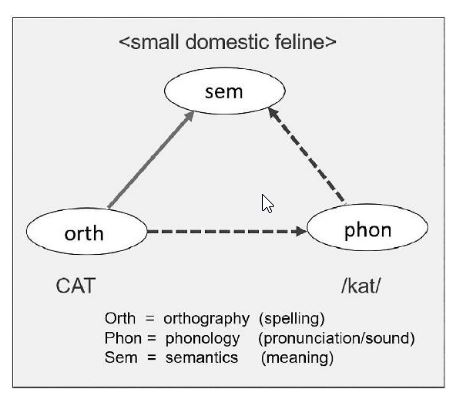Language at the Speed of Sight
In short, reading is interesting. It’s complex, it’s essential, and there is an urgent need to reduce the number of people who read little or not at all and to ensure that future generations will be sufficiently literate to thrive in the world they will inhabit. Out of such elements emerged a science of reading and this book.
- 93 million Americans read at basic or below basic levels
Writing Systems
- writing systems were independently invented three times: Sumeria, China, and Mesoamerica
Four crucial events to the development of writing: 1) Moving from depictions to symbols –> moving on from the idea that a picture represented one real thing to the idea that symbols could represent abstract or concrete things 2) Representing entire languages –> develop working writing systems for not just some objects or concepts but the entire language 3) Discovering phonology –> speech consists of phonological units, and writing needed to evolve to represent that 4) Establishing congruence –> properties of writing systems need to align with properties of spoken language
A word is a hub linking many types of information: its sound, pronunciation, and spelling; its multiple senses (e.g., drinking utensil, unit of measurement, trophy); the entities to which it refers (e.g., types of cups), as well as the sensory and perceptual properties of those entities, their functions, and how to use them; facts such as where they are made, bought, and kept and which is Mother’s favorite; their grammatical functions (e.g., “cup” is both noun and verb) and how the word combines with others to form expressions such as “sippy cup” and “cuplike.” The density of the information linked to a word reflects what the child knows about many things beyond a simple association between form and meaning. (110)
Teaching Reading
third-trimester fetuses are already learning about statistical properties of their mother’s speech that make it English rather than Russian (87)
Reading to children is not the same as teaching children to read (114)
Reading to children serves a lesser-known function that is at least as important as introducing them to print: expanding their knowledge of spoken language (115)
- On the importance of reading to children
Van Orden Effect - There was a long debate on whether reading is visual or phonological (sound-based), but van Orden did some tests that showed that phonological information is an essential skill in reading proficiency.
I would start by changing teacher training, focusing preschools on language exposure, and modifying curricula and assessment practices to reflect differences in language background with particular attention to removing casual but pernicious biases and unfair comparisons. Much attention has recently focused on the role of personal traits such as self-motivation, tenacity, perseverance, and “grit” in achievement. I would add that engagement in a task such as learning to read also depends on success, and that failure is a strong disincentive, especially when it is in part built in.
- Talking about african american vernacular english and how racial gaps in reading skills
Speed Reading
As the eye moves from left to right, it makes brief pauses, called fixations. The rapid jumps between fixations are called saccades. The number of fixations, the amount of time spent on each, and the size of the saccades are the major determinants of reading times. (The saccades themselves only add about twenty to thirty milliseconds each.) (63)
Some basic facts:
- About seven to eight letters are read clearly on each fixation.
- Fixation durations average around 200 to 250 milliseconds (four to five per second).
- Words in most texts are about five letters long on average.
- 4 fixations per second = 240 fixations per minute
- 240 fixations × 7 letters per fixation = 1,680 letters per minute
- 1,680 letters/6 (five letters per word plus a space) = 280 words per minute
This is why the inducement to “suppress subvocalization” in order to speed read is a sham (128)
- When talking about speed reading claims and whether they are valid. Seidenberg dismantles the three central ideas of speed reading: 1) take in more information at a time, 2) eliminate subvocalizations 3) eliminate regressive eye movements, as well as ideas that we can change the text to deliver information faster to the reader. Speed reading is a sham.
The Eternal Triangle
Dyslexia is thus the purposeful medicalization of normal behavior: both part of a normal distribution and treatable condition (158)
- Talking about whether dyslexia exists or is just the natural result of the bell curve of reading competency
My view is that his observations about dyslexia are so shallow they shouldn’t merit serious attention (180)
- When talking about Maclolm Gladwell’s contention, in his 2013 book David and Goliath, that dyslexia might be a desirable difficulty. Seidenberg goes on to eviscerate the argument further
